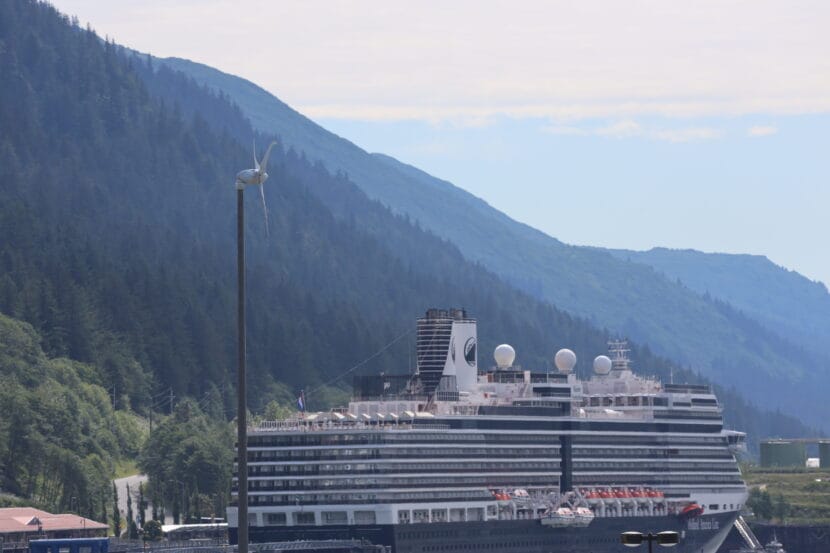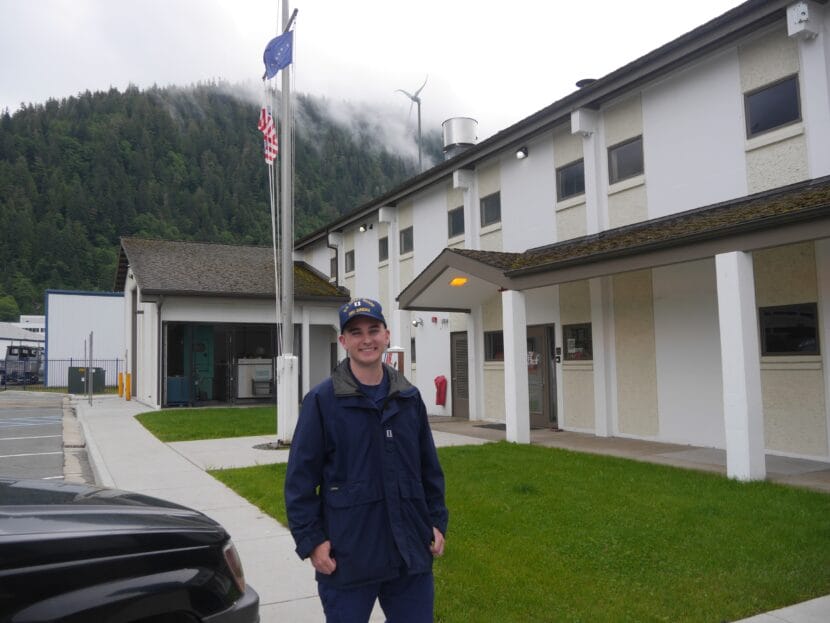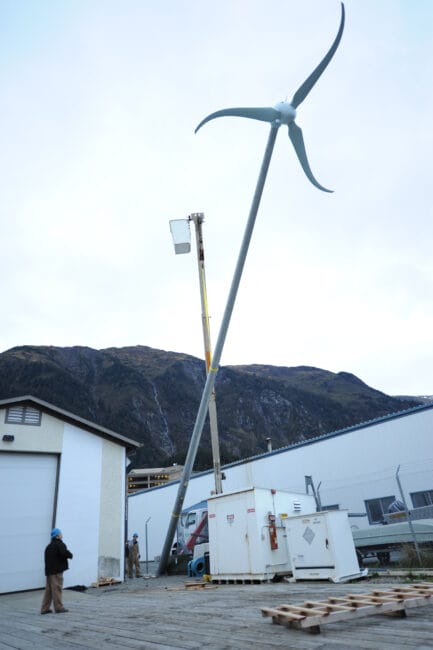Gå frakoblet med Player FM -appen!
Juneau is a windy city. So why don’t we have more wind turbines?
Manage episode 426000789 series 1457379

On a windy day in Juneau, you can see state flags fluttering along Egan Drive or a bald eagle coasting over Gastineau Channel. On the pier behind U.S. Coast Guard Station Juneau, you might catch the blur of a wind turbine’s blades.

“It really spins in the wind and it makes a neat little whipping sound as it goes,” said energy educator Clay Good. He works for Renewable Energy Project Alaska. “So everybody notices it and wonders, ‘Hmm. Can we do more wind energy here?’”
For this Curious Juneau, a KTOO listener asked just that.
According to Lt. Kyle Hansen, the 60-foot miniature wind turbine at Coast Guard Station Juneau was installed back in 2010, following an executive order that called for more renewable energy at federal facilities.
The turbine was also used as a teaching tool for high school students to learn about wind energy through a nationwide program called Wind for Schools. The same program brought a twin turbine to Sitka.

The educational component is defunct now, but the turbine on Juneau’s waterfront is still producing electricity — about 1,500 kilowatt hours per month.
“Which turns into about 7% of Station Juneau’s needs,” Hansen said.
A turbine this size could also easily power the average U.S. household, which needs about 900 kilowatt hours of electricity per month. And Hansen said it’s saved the Coast Guard some money, too.
“It’s produced about $25,000 worth of electricity for the station,” he said.
This is just a mini-turbine. The ones you might see on a wind farm can usually power almost 1,000 homes, and the cost of wind-generated electricity is dropping.
So why not build more wind turbines in Juneau?
It turns out, our rugged landscape is not quite right.
“Wind turbines are often seen in areas of more open space around them, where there’s a smooth laminar wind,” Good said.
Laminar winds are streamlined and consistent — Juneau’s winds are anything but that. When a breeze hits steep mountains and drops into Gastineau Channel, it often becomes turbulent, irregular and chaotic. And like airplanes, wind turbines don’t like turbulence.

In 2005, the Alaska Energy Authority did a study on wind resources for dozens of communities across the state. They rated the feasibility of wind power on a scale of one to seven. At sea level, Juneau scored one — a poor rating.
On the mountaintops, it might be a different story.
“That’s a lovely place to capture the wind,” Good said. “But it’s not a lovely place to build a turbine. It’s not a lovely place to maintain one.”
Wind on the ridges is great for wind power on average, but at the extremes — especially in the winter — it’s too strong for a turbine to withstand.
So Juneau’s wind, though powerful, is not really the right kind of wind. Perhaps more importantly, wind power faces a big renewable power competitor here.
The same mountains that create turbulent winds also create rushing creeks and streams, making for really reliable hydropower. Deep mountain basins can store that water throughout the rainy season, and it can be used to create energy later on, during drier times. Wind and solar power, on the other hand, require expensive batteries to store energy.
“We just had that extraordinary good fortune of having these hydro resources,” Good said. “It’s hard to even think about anything else.”
When a community wants to generate large-scale renewable power, there’s often a high start-up cost to build the infrastructure. That’s especially true for hydropower projects.
But Juneau got a head start with hydro. Back in the late 1890s, water was the easiest way to power a bustling mining industry.
“It’s not like 125 years ago, a bunch of conservationists and greenies moved to Juneau and said, ‘We’re gonna have green power here,” Good said. “It was just the power that was available.”
The first hydro powerhouse at Gold Creek later evolved into Juneau’s sole utility, Alaska Electric Light and Power. Today, they provide Juneau with 100% renewable electricity for relatively cheap. But that doesn’t mean Juneau is a renewable utopia.
Hydroelectricity only covers about 20% of the total energy used by the city. A lot of transportation and home heating still relies on fossil fuel like heating oil, diesel and gasoline.
So eventaully, Juneau might need more renewable power to keep cutting down greenhouse gas emissions. But there’s a lot more hydropower potential to tap into.
“Southeast Alaska was made for hydro,” Good said. “I think rain was invented here.”
Curious Juneau
Are you curious about Juneau, its history, places and people? Or if you just like to ask questions, then ask away!
- What do you want to know about Juneau?
- Name*First Last
- Email*
- Phone
- Zip Code ZIP / Postal Code
- CAPTCHA
20 episoder
Manage episode 426000789 series 1457379

On a windy day in Juneau, you can see state flags fluttering along Egan Drive or a bald eagle coasting over Gastineau Channel. On the pier behind U.S. Coast Guard Station Juneau, you might catch the blur of a wind turbine’s blades.

“It really spins in the wind and it makes a neat little whipping sound as it goes,” said energy educator Clay Good. He works for Renewable Energy Project Alaska. “So everybody notices it and wonders, ‘Hmm. Can we do more wind energy here?’”
For this Curious Juneau, a KTOO listener asked just that.
According to Lt. Kyle Hansen, the 60-foot miniature wind turbine at Coast Guard Station Juneau was installed back in 2010, following an executive order that called for more renewable energy at federal facilities.
The turbine was also used as a teaching tool for high school students to learn about wind energy through a nationwide program called Wind for Schools. The same program brought a twin turbine to Sitka.

The educational component is defunct now, but the turbine on Juneau’s waterfront is still producing electricity — about 1,500 kilowatt hours per month.
“Which turns into about 7% of Station Juneau’s needs,” Hansen said.
A turbine this size could also easily power the average U.S. household, which needs about 900 kilowatt hours of electricity per month. And Hansen said it’s saved the Coast Guard some money, too.
“It’s produced about $25,000 worth of electricity for the station,” he said.
This is just a mini-turbine. The ones you might see on a wind farm can usually power almost 1,000 homes, and the cost of wind-generated electricity is dropping.
So why not build more wind turbines in Juneau?
It turns out, our rugged landscape is not quite right.
“Wind turbines are often seen in areas of more open space around them, where there’s a smooth laminar wind,” Good said.
Laminar winds are streamlined and consistent — Juneau’s winds are anything but that. When a breeze hits steep mountains and drops into Gastineau Channel, it often becomes turbulent, irregular and chaotic. And like airplanes, wind turbines don’t like turbulence.

In 2005, the Alaska Energy Authority did a study on wind resources for dozens of communities across the state. They rated the feasibility of wind power on a scale of one to seven. At sea level, Juneau scored one — a poor rating.
On the mountaintops, it might be a different story.
“That’s a lovely place to capture the wind,” Good said. “But it’s not a lovely place to build a turbine. It’s not a lovely place to maintain one.”
Wind on the ridges is great for wind power on average, but at the extremes — especially in the winter — it’s too strong for a turbine to withstand.
So Juneau’s wind, though powerful, is not really the right kind of wind. Perhaps more importantly, wind power faces a big renewable power competitor here.
The same mountains that create turbulent winds also create rushing creeks and streams, making for really reliable hydropower. Deep mountain basins can store that water throughout the rainy season, and it can be used to create energy later on, during drier times. Wind and solar power, on the other hand, require expensive batteries to store energy.
“We just had that extraordinary good fortune of having these hydro resources,” Good said. “It’s hard to even think about anything else.”
When a community wants to generate large-scale renewable power, there’s often a high start-up cost to build the infrastructure. That’s especially true for hydropower projects.
But Juneau got a head start with hydro. Back in the late 1890s, water was the easiest way to power a bustling mining industry.
“It’s not like 125 years ago, a bunch of conservationists and greenies moved to Juneau and said, ‘We’re gonna have green power here,” Good said. “It was just the power that was available.”
The first hydro powerhouse at Gold Creek later evolved into Juneau’s sole utility, Alaska Electric Light and Power. Today, they provide Juneau with 100% renewable electricity for relatively cheap. But that doesn’t mean Juneau is a renewable utopia.
Hydroelectricity only covers about 20% of the total energy used by the city. A lot of transportation and home heating still relies on fossil fuel like heating oil, diesel and gasoline.
So eventaully, Juneau might need more renewable power to keep cutting down greenhouse gas emissions. But there’s a lot more hydropower potential to tap into.
“Southeast Alaska was made for hydro,” Good said. “I think rain was invented here.”
Curious Juneau
Are you curious about Juneau, its history, places and people? Or if you just like to ask questions, then ask away!
- What do you want to know about Juneau?
- Name*First Last
- Email*
- Phone
- Zip Code ZIP / Postal Code
- CAPTCHA
20 episoder
Alle episoder
×Velkommen til Player FM!
Player FM scanner netter for høykvalitets podcaster som du kan nyte nå. Det er den beste podcastappen og fungerer på Android, iPhone og internett. Registrer deg for å synkronisere abonnement på flere enheter.




